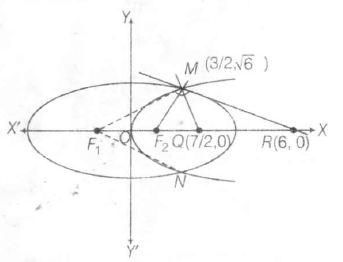Answer:
Option C
Explanation:
Equation of tangent at $M(3/2,\sqrt{6})$ to $\frac{x^{2}}{9}+\frac{y^{2}}{8}=1$ is
$\frac{3}{2}.\frac{x}{9}+\sqrt{6}.\frac{y}{8}=1$ .........(i)
which intersect X-axis at (6,0)
Also, equation of tangent at $N(3/2. -\sqrt{6})$ is
$\frac{3}{2}.\frac{x}{9}-\sqrt{6}.\frac{y}{8}=1$ ...........(ii)
Eqs. (i) and (ii) intersect on X-axis at R (6.0) ..........(iii)
Also normal at $M(3/2. \sqrt{6})$ is
$Y-\sqrt{6}=-\frac{\sqrt{6}}{2}(x-\frac{3}{2})$
On solving with y=0,
we get $Q(\frac{7}{2},0$ ............(iv)

$\therefore$ Area of $\triangle MQR=\frac{1}{2}(6-\frac{7}{2})\sqrt{6}=\frac{5\sqrt{6}}{4}$ sq units
and area of quadrilateral $MF_{1}NF_{2}$
$=2\times\frac{1}{2}[1-(-1)]\sqrt{6}=2\sqrt{6}$ sq units
$\therefore$ Area of $\triangle MQR$ / Area of quadrilateral $MF_{1}NF_{2}$ = $\frac{5}{8}$